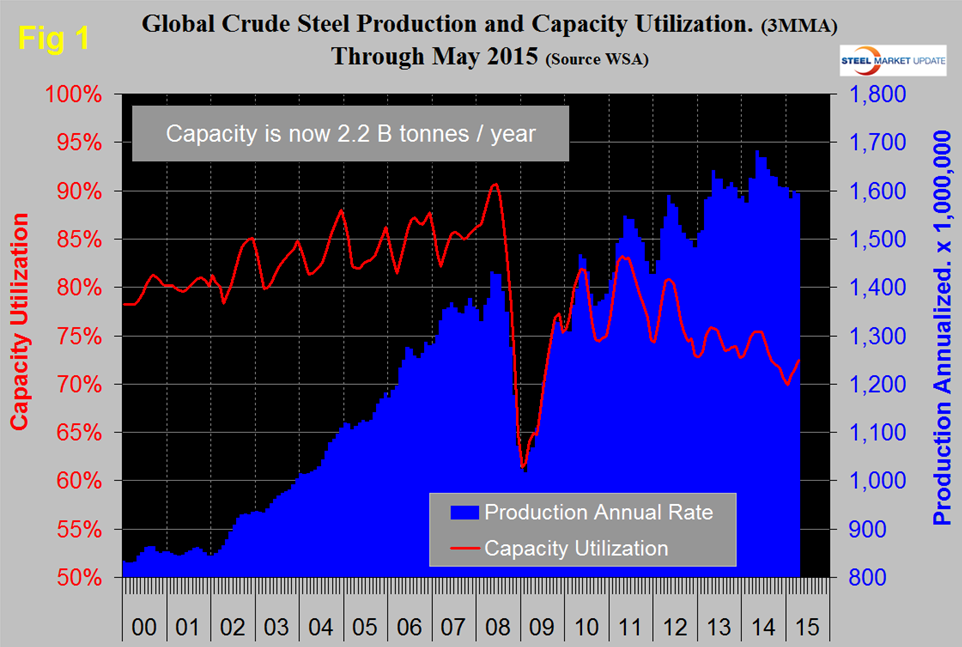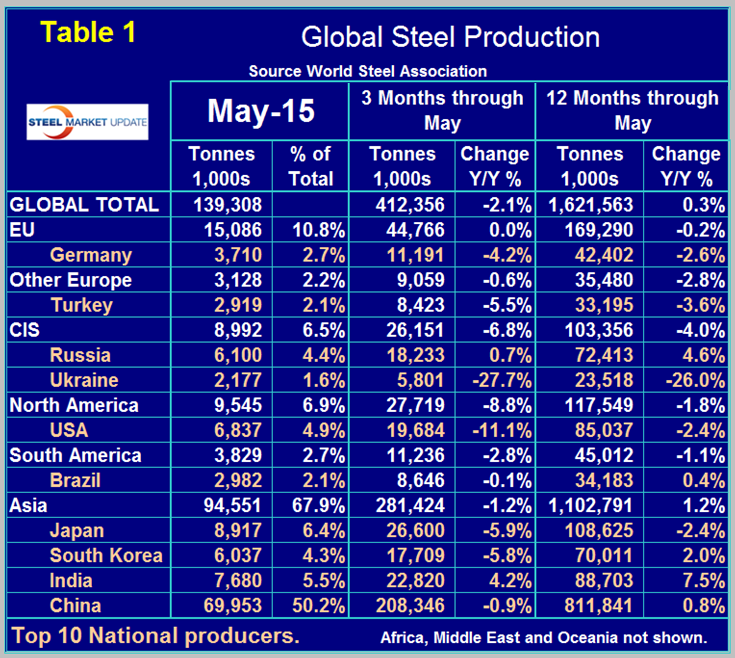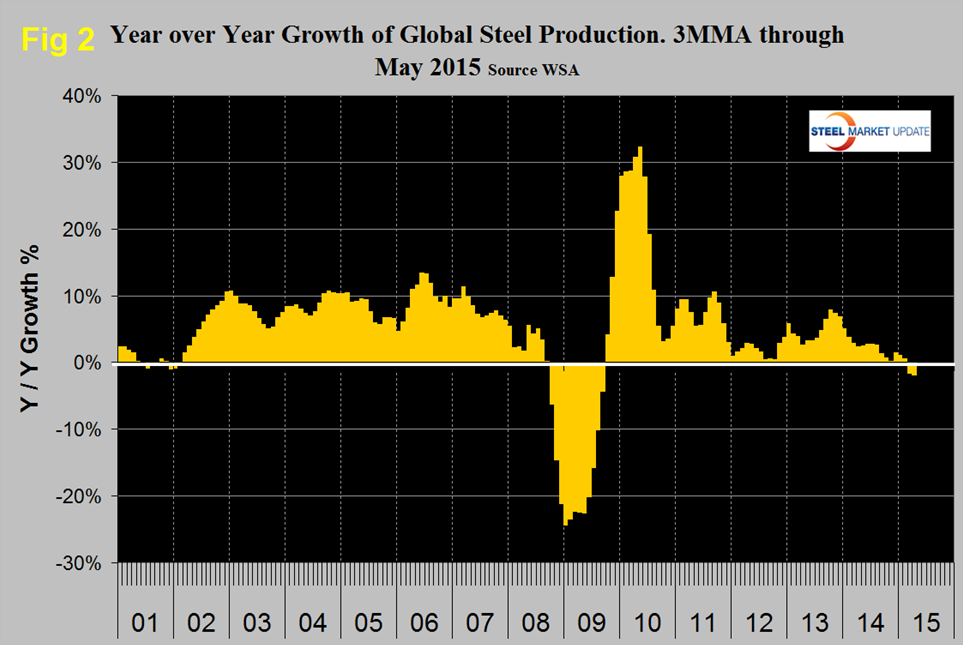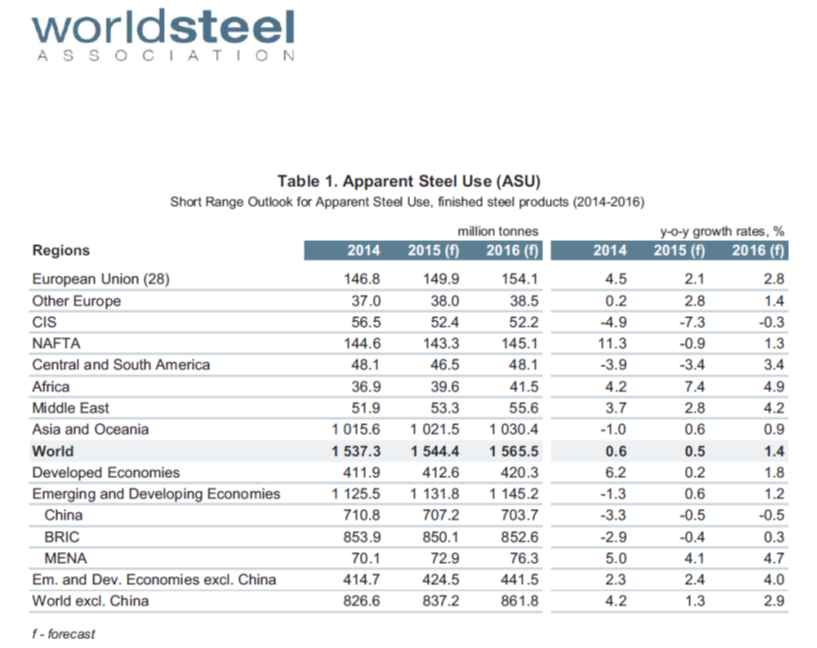International Steel Mills

Asia Accounts for 67.9% of Global Steel Production
Written by John Packard
June 22, 2015
Global steel production in 12 months through May totaled 1.672 billion metric tonnes with a capacity of 2.2 billion tonnes according to the World Steel Association. Capacity utilization on a three month moving average, (3MMA) basis was 72.2 percent unchanged from April.
China accounted for 50.2 percent of global production in May. Asia as a whole, including India, accounted for 67.9 percent. Production in May on a tons per day basis was 4.494 million tonnes, up from 4.484 in April.
This was the highest tons / day month since last June but the seasonal pattern evident since the recession is different in 2015. Total May production was 139.308 million tonnes. If we look at the three month moving average and plot it over time, we see that there has been a significant decline in the second half of the year since and including 2010 which usually extends into February, after which production kicks up rapidly, (Figure 1). This is not happening in 2015 through May. As production has increased each year since the recession, capacity utilization has decreased, the gap is widening and has been estimated that surplus capacity is currently as much as 500 million tons per year, well over half of which is in China.
Table 1 shows global production broken down into regions and also the production of the top ten nations in the single month of May and their share of the global total. It also shows the latest three months and twelve months production through May with year over year growth rates for each. Regions are shown in white font and individual nations in beige. If the three month growth rate exceeds the twelve month we interpret this to be a sign of positive momentum and accelerating growth. The reverse is the case today for all regions except Europe.
Comparing the three months through May in 2014 and 2015, the only nations in the top 10 to have positive growth were Russia and India with 0.7 percent and 4.2 percent respectively, this was also the case in April. In the May data China was down by 0.9 percent in three months through May year over year, North America was down by 11.1 percent in total with the US down by 11.1 percent, Canada up by 7.5 percent and Mexico down 8.7 percent.
The European Union was unchanged and other Europe, led by Turkey, was down by 0.6 percent. The effect of the war in Ukraine is clear in the contraction of that country’s steel production. Platts reported this month that mill sources in central and eastern China said that, apart from some long-scheduled annual maintenance, major steel mills would not reduce output this month or next. Not only were the mills obliged to protect their market shares, but also local governments were against cutbacks as local employment would be affected.
Figure 2 shows the 3MMA of the monthly year over year growth of global steel production which was negative in March for the first time since September 2009. April and May were both down by 2.1 percent year over year. On a three month moving average basis, global growth contracted for five straight months from positive 1.4 percent in December to negative 2.1 percent in April then was unchanged in May. The growth rate in twelve months through May 2015 was 0.3 percent compared to twelve months through May last year.
We are again publishing the latest World Steel Association Short Range Outlook forecast for apparent steel consumption in 2015 and 2016. As we stated last month the forecast for 2015 looks optimistic and that is increasingly the case, (Table 2). (Note this forecast is steel consumption, not crude steel production which is the main thrust of what you are reading now.) WSA are forecasting a 0.5 percent growth in demand this year followed by 1.4 percent in 2016.
Based on this analysis by the WSA, NAFTA has by far the largest deterioration in demand between 2014 and 2015, changing from +11.3 last year to – 0.9 percent this year. We read the global trends as worse than the WSA forecast suggests and the NAFTA trend as better. The recent decline in the price of oil, of iron ore and of the Baltic Index suggests that the global economy is weakening. Certainly there is a supply side to all three of those measures, but it seems that demand is also down and suggests a further slowdown in global steel production in 2015.

John Packard
Read more from John PackardLatest in International Steel Mills
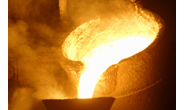
Global steel mill output steady through May
Global raw steel production rose 2% from April to May, slightly above average production levels seen in recent months, according to data recently released by the World Steel Association (worldsteel).

Trump says US government to control 51% share in USS
President Trump says the US government will hold a 51% stake in U.S. Steel after the Nippon deal.

USS, Nippon Steel quiet as litigation deadline approaches
There has been little word from U.S. Steel, Nippon Steel, or the White House since President Trump endorsed the companies’ “partnership” on social media and celebrated it at the May 30 rally outside Pittsburgh.

Ternium’s Vedoya named AIST’s Steelmaker of the Year
Maximo Vedoya was awarded in recognition of Ternium’s expansion project in Pesquería, Mexico, and Ternium’s efforts to decarbonize steelmaking.

CRU: Baosteel hints at output cuts in China
Baosteel exec comments on market rumors of 50 million tons of output being cut this year, less than 0.5% of the 1 billion tons-plus China has produced annually in recent years.

